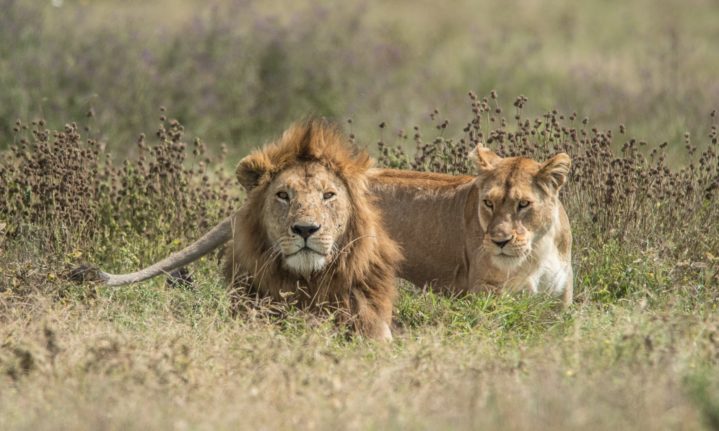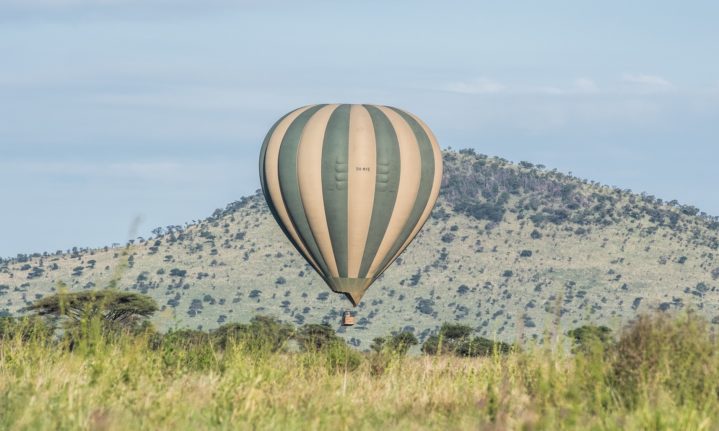Justin Fox fulfils a bucket-list dream and travels to the Serengeti in a time of Covid to witness the greatest migration on Earth
Rounding a bend on Rongai Hill we come upon the herd, the endless herd. A million wildebeest and zebra heading west towards Grumeti in this, the main body of the Great Migration. We are barely able to compute what our eyes are taking in: an ocean of mammals, a vast, seething, living, breathing leviathan.

Justin Fox fulfills a bucket-list dream and travels to the Serengeti in a time of Covid to witness the greatest migration on Earth.
I find myself overwhelmed, struggling to think straight, unable to decide which lens to use, whether to photograph, film or jot notes. Instead, I put my camera down – recording can wait – and drink in the spectacle. It’s a moving landscape of sound and wonder, of pronking, leaping, cantering, grazing, snorting, moseying. Everywhere and everything so alive!
‘Yes, this is Life,’ I think.
The Serengeti had always sat high on my safari wish list but, after nearly 25 years of African travel, the park continued to elude me. It had always seemed like a difficult and expensive destination, and even if you embarked on a self-drive camping trip from South Africa, I’d heard the roads were long and bad, and entrance fees exorbitant.
And so it was that I leapt at the chance, despite restrictions imposed by Covid-19, to visit this corner of Africa during migration season on a tour that was reasonably priced and included all the region’s great sites. Seagull Travel and Tours is a small outfit run from Jeffreys Bay that tailor makes tours for a South African clientele. It’s a slick operation, with all flights, transfers and Covid compliancy ably handled. You travel in well-appointed, open-roofed Land Cruisers and the accommodation is in top-notch camps or hotels.
After a long series of flights, we arrived at Kilimanjaro Airport, met our guides, led by Seagull’s Elizabeth van Niekerk Wait, and set off into the west. Slowly, the urban sprawl of Arusha was replaced by villages and Maasai herd boys tending their cattle and goats.
We reached Lake Manyara National Park and took a slow drive along the shores of this enormous body of water, swollen from torrential summer rains. The forests were lush and tropical, thick with Cape mahogany, tamarind, sycamore fig and sausage trees of outrageous proportions, the glades dancing with the white wings of African migrant butterflies. Our progress was tracked by large troops of olive baboons and blue monkeys. We glimpsed elephant and antelope in the thick undergrowth but our progress was curtailed by flooded roads.

Burchell’s topi in the central Serengeti.
So we pressed on up the escarpment of the Great Rift Valley, through forests dense and dark, around the misty rim of Ngorongoro Crater, down its western flank through the Malanja Depression and finally, after a long and dusty drive, we reached Ndutu Lodge. This lovely tented camp is set in the western corner of the Ngorongoro Conservation Area on the ‘border’ (there are no fences) of Serengeti National Park.
From here we explored the watercourses that fed lakes Masek and Ndutu. There’s so much meaty food hereabouts, that the raptor and scavenger populations are enormous, including packs of hyena, jackal and even the occasional bat-eared fox. We saw dozens of tawny eagles, many of them perched on the ground, almost as plentiful as Trafalgar Square pigeons in London. There were countless feathered undertakers, too: lappet-faced, white-backed and hooded vultures, as well as Rüppell’s griffons and marabou storks.
It wasn’t just the large fowl in rich abundance. We were treated to sightings of white-browed coucal, yellow-throated sandgrouse, lesser and grey kestrels, rufous-tailed weaver, silverbird, and a number of endemics, such as Fischer’s lovebird, grey-breasted spurfowl and D’Arnaud’s barbet.
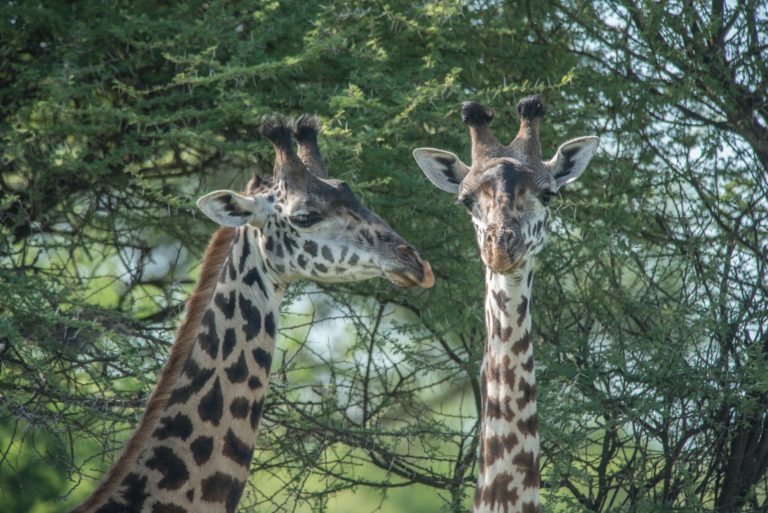
Maasai giraffes south of Mbuzi Mawe Serena Camp.
Heading north and entering Serengeti National Park, the landscape grew increasingly spellbinding: endless grassy plains on a godly scale, like the steppes of Asia or the prairies of America. Indeed, ‘seringit’ means ‘endless plain’ in the Maasai language. Ostriches, like bottom heavy exclamation marks; giraffes, like teetering, metronomic stilt walkers.
The big cats soon made an appearance. First, a pair of lions, the female discernible between mating bouts by her lofted paws, like pale periscopes poking above the grass. Later, a lioness in the top of an umbrella tree, spying out the land; then another feline tightrope walker on a spindly branch. There were plenty of dolerite koppies decorated with big, snoozy cats, like adverts for The Lion King. Over the coming days, we were to see more than 50 lions, as well as the odd serval and a lone leopard up a tree.

A lioness surveys the southern plains from the branch of an umbrella thorn.
As for general game watching, it was fascinating to encounter variants of the mammals we knew so well back in South Africa, such as golden jackal, Coke’s hartebeest, topi, Maasai giraffe, Defassa waterbuck (without the toilet-seat marking on their bums) and, instead of springbok, the ever-present Thomson’s and Grant’s gazelle.
The most common mammals were, unsurprisingly, Burchell’s zebra and western white-bearded wildebeest (not blue, as I’d assumed), the two stars of the East African show. Although the Great Migration remained elusive at first, these two species were abundant everywhere, stragglers of the main body, but large herds nonetheless.
We based ourselves at Mbuzi Mawe Serena, a tented camp set on a boulder koppie with fine views across the plains. From here, we did daily drives in all directions and returned to fireside yarns, dawa (lime) cocktails and lavish braais. In the small hours, we were woken intermittently by the whoop of hyenas and the baritone roaring of lions.
Our game drives were lively affairs. Although it was late May, and theoretically the start of the dry season, we had caught the tail end of the long rains. I had Toto’s Africa playing full volume in my head as we traversed plains chased by thunderstorms that dumped torrential showers and conjured ethereal light.
The rain made for tricky driving conditions though, especially in the black-cotton soil over which we slithered and slewed. Sometimes we got so stuck that digging and towing were not enough. Then two vehicles needed to be enlisted, towing side by side, or one behind the other, or one pushing and one pulling the stricken Cruiser. When all else failed, out came the high-lift jack. Our three Tanzanian guides were well practised in such adversity and never failed to extricate us, usually after a few entertaining bouts of spinning wheels and muddy mayhem.
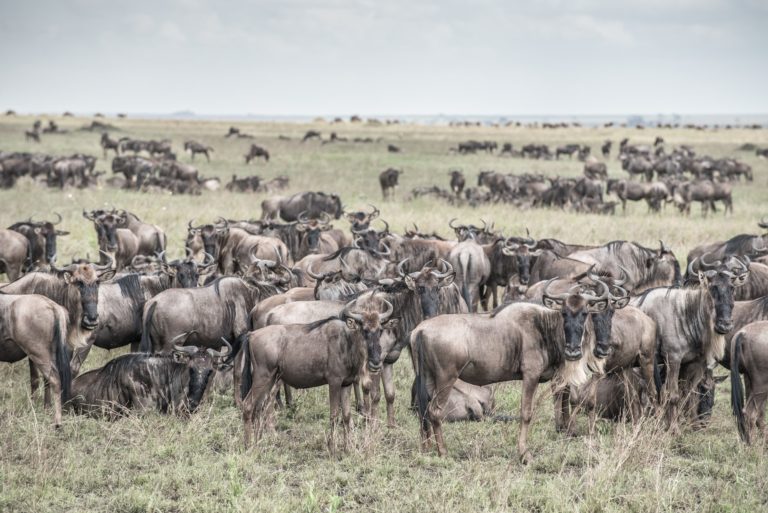
Small groups of wildebeest follow the main migration herd heading west towards Rongai Hills.
The Migration, when we found it, was everything I’d hoped for. With the main herd pressed up against Rongai Hills, the animals were bunched together, the sights and sounds a sensory overload. ‘Gnu, gnu, gnu!’ they chanted, filling the plains with their honking.
We drove among them, cleaving through a mass of mammals like a Red Sea parting, until we reached Lake Magadi, where we stopped for lunch and a chance to take stock of what we’d just witnessed. A flock of feeding flamingos surrounded the peninsula on which we sat munching our sandwiches, and a family of Cape teals paddled by to take a peak at us.
Our elated band returned to camp following the loopy meanderings of the wild date palm-lined Seronera River and came upon a pond filled to the brim with hippos. It looked like a giant Jacuzzi, a great, bobbing, snorting mass of blubbery, pot-bellied grumpiness – the southern-right whales of the Serengeti.

A Jacuzzi of hippos wallow in a Seronera River pond.
The next morning was set aside for hot-air ballooning, which required a criminally early start: 3:45am to be precise. We drove south in the dawn’s first gloaming and reached the launch site just before sunrise. The green-and-khaki striped condom was already semi-inflated as we piled out of the vehicles. Briefing completed, we climbed into the basket and, with a roar of flaming propane, lifted off in time for the sun’s first appearance.
Our balloon ghosted across the plains, only metres above the ground, then soared high over trees, rivers and koppies. We spotted lions on a kill, hyenas and a hunting serval; herds of zebra and giraffe were put to flight as our corpulent shadow passed over them. I was struck by the peacefulness as the Serengeti drifted below us in a trance of golden silence.
All too quickly, our hour was up and the pilot sought an open patch to land. Given the windy conditions, we braced ourselves for a bumpy touchdown. ‘Hold tight!’ called the pilot, as our basket jounced across the grassland until the balloon began to deflate and we tipped over. Breakfast was Full English in the veld with a turbaned host and Champagne to toast our Serengeti ‘wings’.
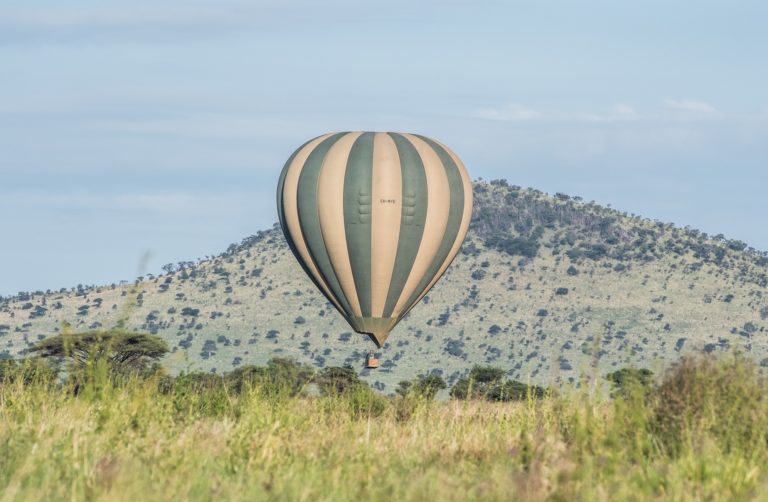
Ghosting above the Seronera plains at dawn with Serengeti Balloon Safaris.
Leaving the park, we headed east, back into Ngorongoro Conservation Area, stopping to visit a remote Maasai village. After a welcome dance – women singing in strange, guttural harmony and men performing straight-legged leaps – we had a chance to meet the clan, enter the huts and find out about their life in the wilderness. It was remarkable to see young herd boys wrapped in red blankets looking after cattle in close proximity to wild animals, and even large predators. The Maasai have developed a symbiotic, animistic way of living and interacting with nature from which Western humans could learn a tremendous amount.
Our home that night was Ngorongoro Serena, a spectacular lodge built from volcanic rock perched on the rim of the crater. The views from every room were debilitating: there was no incentive to do anything but stare. As dusk fell, the crater dialled through a spectrum of pastel colours and a pair of buffalo ambled by. I had to drag myself away to dinner.
Next, we descended into Ngorongoro’s ancient volcano, the remains of a mountain that would once (before it blew its top) have been bigger than Kilimanjaro. The crater is one of the world’s great wildlife experiences, a fertile cauldron 20km in diameter, thronging with more than 25 000 animals. It is, effectively, the planet’s greatest zoo.
Due to Covid-19, the caldera was thankfully devoid of other vehicles. We slowly traversed the crater floor, stopping every few minutes to marvel at the abundance of life: herds of gazelle, wildebeest, buffalo and zebra, browsing elephants, hippo pods and the occasional black rhino. And oh the birdlife! Crested crane, auger buzzard, gull-billed tern, long-toed lapwing, black heron, flamingos by the hundred, waterfowl by the thousand.

Flamingo ballet during a lunch stop beside Lake Magadi.
We came upon a kill: three bloody-faced lions on a wildebeest carcass. Just then, five whooping hyenas pitched up and a tense stand-off ensued. The dogs surrounded the cats, harrying and intimidating them until the felines backed off. Within minutes, a dozen hyenas had joined the feeding frenzy, as well as a few brave jackals that made darting forays to steal the scraps. It was riveting theatre.
That evening, the last of our journey, I sat beside a spill pool at Lake Manyara Serena. The hotel lies on the lip of the Great Rift Valley escarpment with vertiginous views of Lake Manyara far below. East lay Arusha and a long series of flights back to South Africa. I sat long into the dusk, thinking how I’d experienced the best of the Serengeti in this troubled time of Covid. I’d seen the Great Migration and Ngorongoro empty of tourists, a rare and probably once-in-a-lifetime privilege. The journey had shown me an ecosystem that was rich, unspoilt, self-sustaining and utterly wondrous, a wilderness in the heart of Africa precious beyond words.
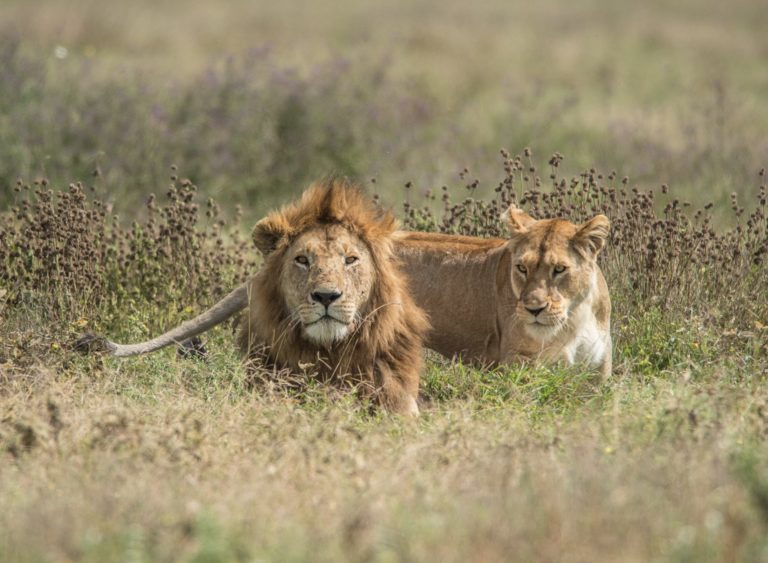
A pride on the prowl, Serengeti lions take advantage of tall grass to conceal themselves from prey.
The Great Migration
Wildebeest, zebra and gazelle migrate north from the Serengeti through the winter months, following the path of the rains, which bring sweet new grass to the Masai Mara in Kenya. Every winter, two-and-a-half-million animals make this slow, epic journey. Negotiating the gauntlet of predators and fast-flowing rivers they mow the grass down to close-cropped stubble, before making the circular journey back to the Serengeti when spring rains bring new life to the southern plains. It’s the greatest wildlife show on Earth.
Personalities:
Mohamed Masud
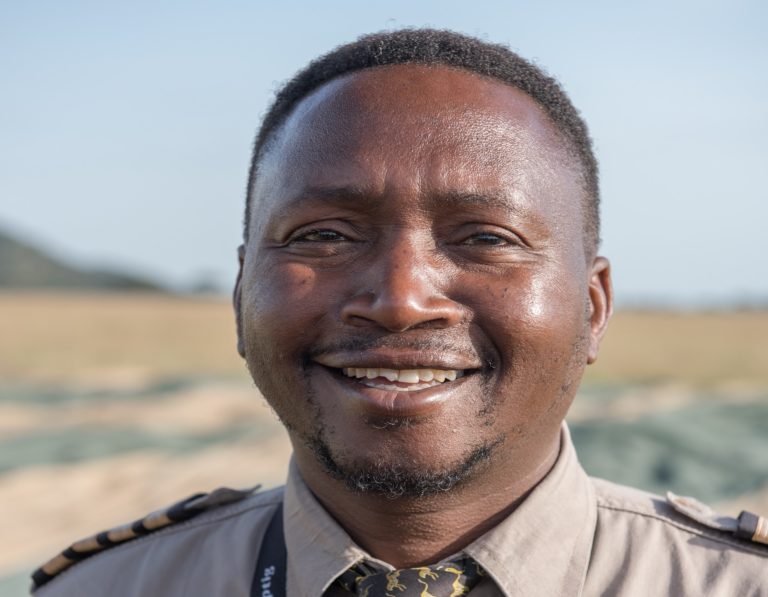
Mohamed Masud was the erudite and witty pilot of our hot-air-balloon ride with Serengeti Balloon Safaris. He hails from Kilimanjaro, did his flight training in the USA in 2001 and has been flying in Tanzania (Ruaha and Serengeti) ever since. He was the country’s first ballooner and has clocked nearly 4 000 hours in the air. ‘I love the surprise factor of each day,’ he says. ‘The weather, the animals, nature – every flight is an adventure. What’s more, you can only go where the wind decides to take you…’ balloonsafaris.com
Salim Msafiri

Based in Arusha, Salim Msafiri has been guiding for 13 years, although to date he has conducted only three safaris during the devastating Covid period. Salim started his career with a diploma in automobile engineering but got drawn back to nature and switched to studying tourism. ‘My father worked as a transport manager in Ngorongoro, so I grew to love this environment as a child,’ he explains. ‘My favourite of all is the Serengeti: the diversity of the landscape, fauna and flora.’
Elizabeth van Niekerk Wait

Elizabeth van Niekerk Wait of Seagull Travel & Tours studied tourism at Boland College and a BA in English at Stellenbosch University, before joining the family travel business. She has a particular passion for Tanzania (in fact, she got married at Ndutu Lodge) and has been leading groups to the country for 15 years. ‘I adore the Tanzanian people, how proud and resourceful they are,’ she says. ‘And the vast open spaces that are so characteristic of this corner of Africa are simply spellbinding.’
Plan your trip:
When to go
The best time to catch the Great Migration in the Serengeti is from late May to July (in the centre and western corridor), and from August to September in the north of the park.
About Seagull Travel & Tours
Over the past 20 years, Seagull Travel & Tours has been designing trips with the South African traveller in mind. The agency specialises in group tours at affordable prices and forges a close relationship with its clients (individualised trips can also be arranged). Seagull offers a wide range of destinations in Africa, Europe, Asia and South America.
A Seagull representative accompanies every group, ensuring a smooth travel experience. When you arrive at a destination, you’re also joined by a knowledgeable guide from the host country, who stays with the group for the duration of the tour.
042 296 0475, seagulltours.co.za
Our Serengeti tour
Seagull’s trips to Tanzania are usually conducted in May and June (and to Kenya in August, as well as a ‘calving’ tour in February) to coincide with the Migration. Rates for a 10-day tour start from R44 400 per person and this includes all flights (we flew Ethiopian Airlines), transfers, meals, game activities and accommodation in four- or five-star lodges. We stayed at Arusha Coffee Lodge, Lake Manyara Serena Safari Lodge, Ndutu Safari Lodge, Mbuzi Mawe Serena Camp and Ngorongoro Serena Safari Lodge.













